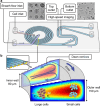Epistasis regulates genetic control of cardiac hypertrophy
- PMID: 40473955
- PMCID: PMC12170338
- DOI: 10.1038/s44161-025-00656-8
Epistasis regulates genetic control of cardiac hypertrophy
Abstract
Although genetic variant effects often interact nonadditively, strategies to uncover epistasis remain in their infancy. Here we develop low-signal signed iterative random forests to elucidate the complex genetic architecture of cardiac hypertrophy, using deep learning-derived left ventricular mass estimates from 29,661 UK Biobank cardiac magnetic resonance images. We report epistatic variants near CCDC141, IGF1R, TTN and TNKS, identifying loci deemed insignificant in genome-wide association studies. Functional genomic and integrative enrichment analyses reveal that genes mapped from these loci share biological process gene ontologies and myogenic regulatory factors. Transcriptomic network analyses using 313 human hearts demonstrate strong co-expression correlations among these genes in healthy hearts, with significantly reduced connectivity in failing hearts. To assess causality, RNA silencing in human induced pluripotent stem cell-derived cardiomyocytes, combined with novel microfluidic single-cell morphology analysis, confirms that cardiomyocyte hypertrophy is nonadditively modifiable by interactions between CCDC141, TTN and IGF1R. Our results expand the scope of cardiac genetic regulation to epistasis.
© 2025. The Author(s).
Conflict of interest statement
Competing interests: E.A.A. is a founder of Personalis, Deepcell, Svexa, Candela, Saturnus Bio and Parameter Health; an advisor to SequenceBio, Foresite Labs, Pacific Biosciences and Versant Ventures; a non-executive director for AstraZeneca and Svexa; and a stockholder in Pacific Biosciences and AstraZeneca; and has received in-kind collaborative support from Illumina, Pacific Biosciences, Oxford Nanopore, Cache and Cellsonics. V.N.P. is a Scientific Advisory Board (SAB) member for and receives research support from BioMarin, Inc., a SAB member for Lexeo Therapeutics and a consultant for Constantiam Biosciences and viz.ai. C.S.W. is a consultant for AiRNA Bio and Avidity Biosciences. While these companies may have interests in genomics or cardiovascular health, they had no direct role in the design, data presentation, analysis or interpretation of this study. The other authors declare no competing interest.
Figures
















Update of
-
Deciphering epistatic genetic regulation of cardiac hypertrophy.medRxiv [Preprint]. 2025 Apr 11:2023.11.06.23297858. doi: 10.1101/2023.11.06.23297858. medRxiv. 2025. Update in: Nat Cardiovasc Res. 2025 Jun;4(6):740-760. doi: 10.1038/s44161-025-00656-8. PMID: 37987017 Free PMC article. Updated. Preprint.
-
Epistasis regulates genetic control of cardiac hypertrophy.Res Sq [Preprint]. 2023 Nov 20:rs.3.rs-3509208. doi: 10.21203/rs.3.rs-3509208/v1. Res Sq. 2023. Update in: Nat Cardiovasc Res. 2025 Jun;4(6):740-760. doi: 10.1038/s44161-025-00656-8. PMID: 38045390 Free PMC article. Updated. Preprint.
References
-
- Weldy, C. S. & Ashley, E. A. Towards precision medicine in heart failure. Nat. Rev. Cardiol. 18, 745–762 (2021). - PubMed
-
- Burkhoff, D., Mirsky, I. & Suga, H. Assessment of systolic and diastolic ventricular properties via pressure–volume analysis: a guide for clinical, translational, and basic researchers. Am. J. Physiol. Heart Circ. Physiol.289, H501–H512 (2005). - PubMed
-
- Haider, A. W., Larson, M. G., Benjamin, E. J. & Levy, D. Increased left ventricular mass and hypertrophy are associated with increased risk for sudden death. J. Am. Coll. Cardiol.32, 1454–1459 (1998). - PubMed
MeSH terms
Substances
Grants and funding
- R01GM152718/U.S. Department of Health & Human Services | NIH | National Institute of General Medical Sciences (NIGMS)
- K08HL167699/U.S. Department of Health & Human Services | National Institutes of Health (NIH)
- K08 HL167699/HL/NHLBI NIH HHS/United States
- L30 HL159413/HL/NHLBI NIH HHS/United States
- 23CDA1042900/American Heart Association (American Heart Association, Inc.)
- R01 GM152718/GM/NIGMS NIH HHS/United States
- K08 HL143185/HL/NHLBI NIH HHS/United States
- K08HL143185/U.S. Department of Health & Human Services | NIH | National Heart, Lung, and Blood Institute (NHLBI)
- IIS 1741340/National Science Foundation (NSF)
- R01 HL144843/HL/NHLBI NIH HHS/United States
- 1R01HL144843/U.S. Department of Health & Human Services | NIH | National Heart, Lung, and Blood Institute (NHLBI)
- DMS-1613002/National Science Foundation (NSF)
- L30HL159413/U.S. Department of Health & Human Services | NIH | National Heart, Lung, and Blood Institute (NHLBI)
- R01HL105993/U.S. Department of Health & Human Services | National Institutes of Health (NIH)
- R01 HL150394/HL/NHLBI NIH HHS/United States
- F32HL160067/U.S. Department of Health & Human Services | NIH | National Heart, Lung, and Blood Institute (NHLBI)
- R01 HL105993/HL/NHLBI NIH HHS/United States
- 23POST1023278/American Heart Association (American Heart Association, Inc.)
- DGE-2146752/National Science Foundation (NSF)
- R01 HL164675/HL/NHLBI NIH HHS/United States
- F32 HL160067/HL/NHLBI NIH HHS/United States
LinkOut - more resources
Full Text Sources
